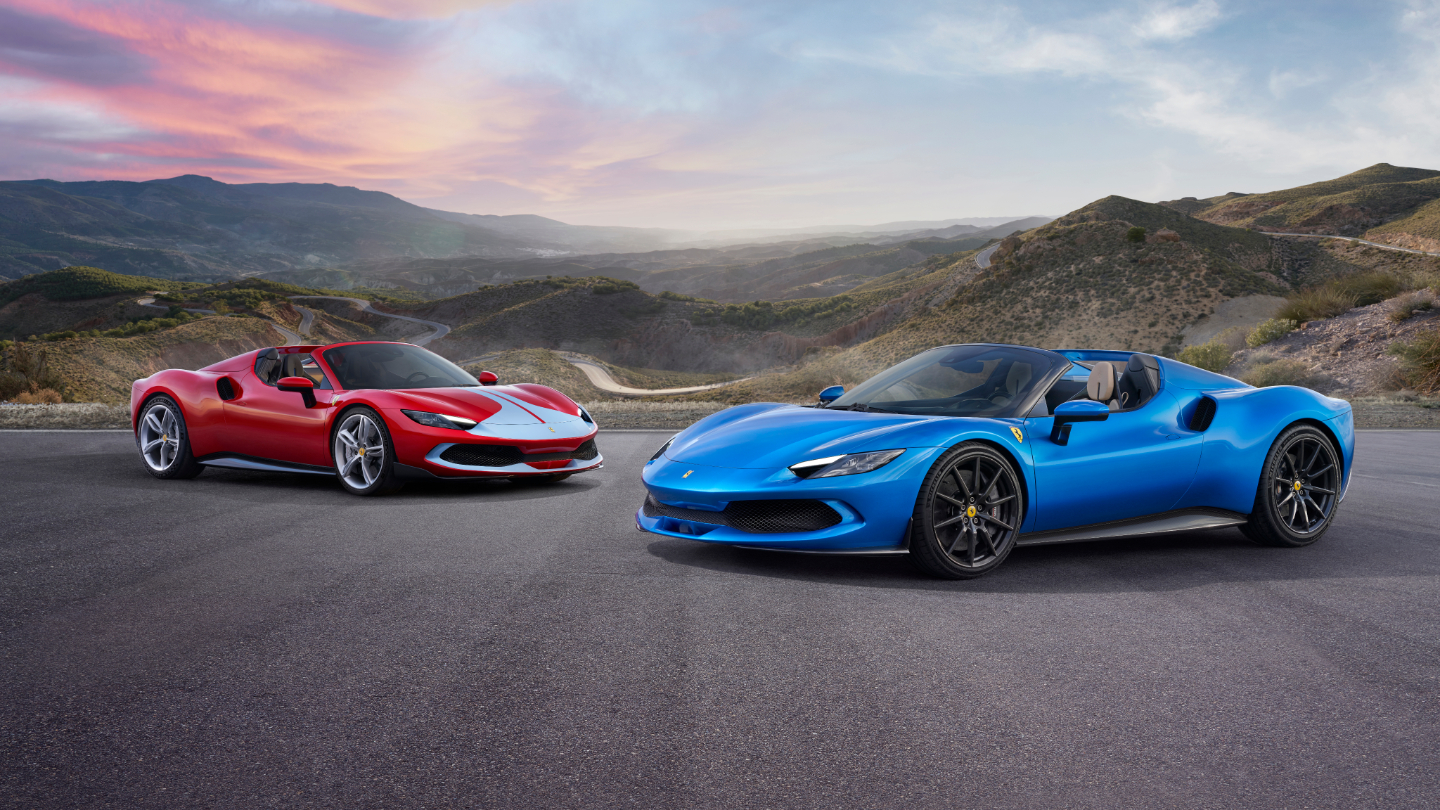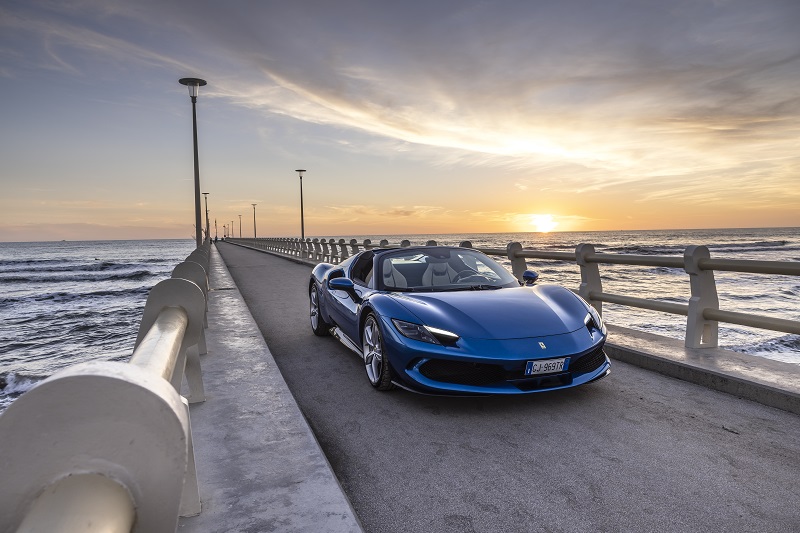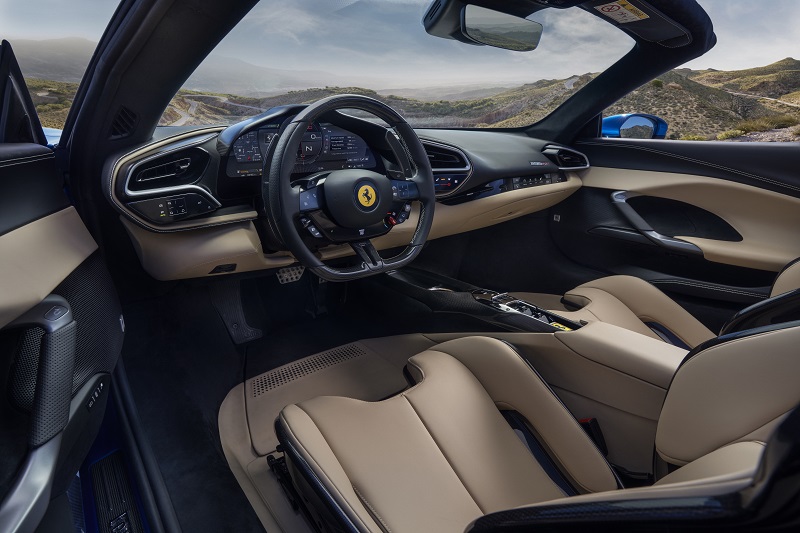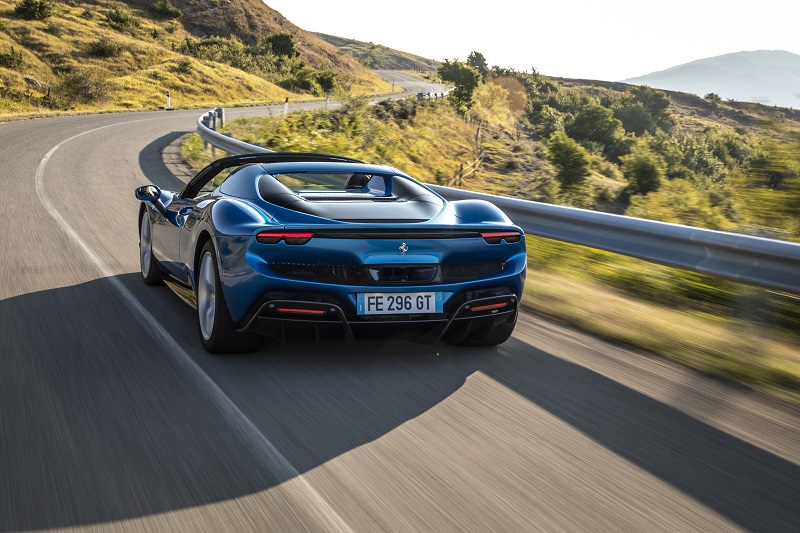
The 296 GTS is also available with the Assetto Fiorano package (left), which includes lightweight features and aero modifications (All photos: Ferrari)
If anyone is familiar with a life of indulgence, it is the Italians. The European country just about embodies richness, whether in food, wine, culture, history, art, fashion or architecture. Play word association and those terms may well be in your top 10 to identify Italy, but in the top five, there will always be a place occupied by Ferrari.
A household name and a luminary in the world of motorsports, Ferrari has always had its finger on the pulse of the automotive industry. It would not be a stretch to say oftentimes it controls the heartbeat altogether, and oh how one’s heart beats in the presence of a Prancing Horse. However, this might not be the case for the 296 GTS, or at least not initially — Ferrari’s latest mid-rear-engined two-seater berlinetta spider may very well take your breath away.
The Gran Turismo Spider comes hot on the heels (or wheels) of the 296 GTB, with almost identical specs save for the option of driving with the top down. Both cars were designed concurrently — “Like twins!” agreed the group of engineers and designers during our sharing session at the Principe Hotel in Forte dei Marmi, Tuscany.
It was revealed that one of the main aims for the 296 GTS was to offer exceptional occupant comfort and a silhouette as close to the 296 GTB as possible. The aluminium retractable hard top (RHT) made it viable, transforming the 296 GTS from closed to open in just 14 seconds at a maximum speed of 45kph. It splits into two sections that fold flush over the front of the engine, which helps create balance for the overall design and maintain the engine’s thermal dissipation characteristics. This also allows for a window over the mighty viscera, so one can always look over and admire the new V6 in all its glory.
_h5a7030-2.jpg

The 296 GTS is extremely easy on the eye. Its stylistic trait is its sleekness and formal elegance. “It’s like an F1 car in evening wear,” said product marketing manager Jacopo Marcon. Hawk eyes will notice the homage paid to the 250 Le Mans, especially at the rear, characterised by the lateral air intakes and the shape of the rear wings, and also the presence of a “flying bridge”. The latter is a small screen that separates the cabin and rear deck and can be raised or lowered when the top is retracted to adjust airflow inside the cabin.
The summer was in no hurry to wane in this part of Italy. We were told people in the coastal town usually layer up around this time of year, but the weather remained benign with the Tuscan sun glazing every surface with a warm glow. Forte dei Marmi without its throngs of A-listers and holidaymakers seemed a little out of place, but the vast beach and long roads, now empty in the off season, also evoked contrasting emotions.
On the one hand, there were no partygoers distracting you from the beautiful surroundings. The marble mountains in the near distance, the very ones Michelangelo explored to sculpt David, stood prouder and more prominently, and one could actually hear the lapping of the waves and the breeze in the trees. On the other hand, the streets were empty. And our ride went from 0 to 100kph in 2.9 seconds, to 200 in 7.6.
The juxtaposition reflects the 296 GTS perfectly. What makes this model so special is the coexistence of absolute performance and driveability. Similar to its older twin, the 296 GTS sports a 663 cv 120° V6 powertrain, coupled with an electric motor capable of delivering another 167 cv. That unleashes a ludicrous class-leading 830 cv output for a Ferrari road vehicle — it might as well be a race car. But thanks to its plug-in hybrid (PHEV) system, it is also incredibly usable every day. Set it to eDrive mode and the roar becomes a purr for 25km. Again, it is quite odd. Who could imagine a quiet Ferrari?
04_296_gts_interior_34.jpg

The journey to Maranello promised to be scenic. The weather was splendid, so we held a button that stowed the RHT neatly away. In fact, there was a button for everything — all within reach of the steering wheel. The digital interface required a little getting used to at first, but it became instinctive after that.
There is a thrill that comes from being in command of such a beast, augmented by the parting of cars in the fast lane as the shrill of the engine signalled its approach. It is dangerously addictive how fast the 296 GTS accelerates because of how steady it remains regardless. The vehicle beckons to be pushed to its fullest potential, entrancing the driver to experience the sheer delight bestowed only by a spectacular high-performance car. There is a blazing fire in its belly and it would be a crime not to put it into top gear. This is the time to slide into the Performance and Qualify modes, where the internal combustion engine takes over. Exhilaration peaks in the tunnels as the vehicle’s crescendo reverberates the entire stretch. Supercar fans rolled their windows down to listen to its elaborate harmonics — a mighty symphony that belongs distinctively to the V6.
It is worth noting that everything about the car, even the frequency of its revs, is engineered to be as such. Its makers nicknamed the V6 “piccolo V12” (little V12) because it transmits similar energy, power and torque. But the V6 also offers a new experience. It starts with low, deep and sonorous revs and evolves into a mid-high frequency as the driver begins to stress its mechanics. The patented “hot tube” adopted on the 296 GTB has been completely redesigned for the 296 GTS to further enhance the engine sound when the top is deployed or retracted. It is positioned prior to the exhaust gas treatment systems so that it channels the pure sound into the cabin — much like a stethoscope — which further enhances the experience. Coming out of the tunnel felt almost like a release as the sound liberated itself into the air.
_nor3788.jpg

The circuitous road to Maranello required us to go through the hilly Futa and Raticosa passes, which offered sprawling vistas of rolling hills and vast vineyards. The 296 GTS climbed and meandered steadily and was astonishingly agile and nimble. Later at dinner, the assembled group of international journalists was in unison about the impressive braking system and its responsiveness, not to mention the splendid handling. This is largely by virtue of the active rear spoiler which generates extra downforce as well as the aero development work. The car was put into eDrive when we approached the quaint towns on the hills. Running on a fully-charged battery, the car went quiet. But the soundlessness did not seem so odd anymore. We pulled the car off the road to a lookout to take in the magnificent view — it deserved stillness. There was not a single soul in sight.
The car was put into Hybrid mode for the rest of the journey. The sun began its descent and the chill of the night crept into the cabin, denoting the coming of autumn. We deployed the RHT while approaching a traffic light and completed our course leisurely.
For those who want to bring their cars to the track, there is always the 296 GTS Assetto Fiorano package, which significantly reduces its weight and sharpens its aerodynamics.
In short, the 296 GTS was extremely satisfying to drive. It presented itself as a partner in crime on the highways and a quiet confidant on the byways. The driving experience was rich and such was only made possible by hands and minds that turned their dreams into reality. Settled into our seats at the beautifully refurbished Ristorante Cavallino, with old photographs of Ferrari’s greats hanging on the walls, we filled our glasses with Lambrusco and toasted the immutable Italian brand. Bravo!
This article first appeared on Nov 7, 2022 in The Edge Malaysia.


